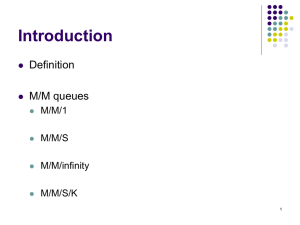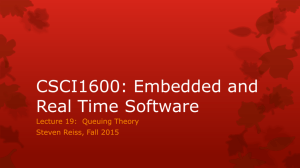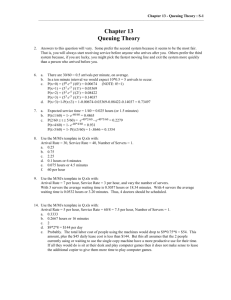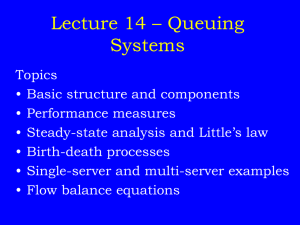Chapter III p TRANSPORTATION SYSTEM ANALYSIS
advertisement
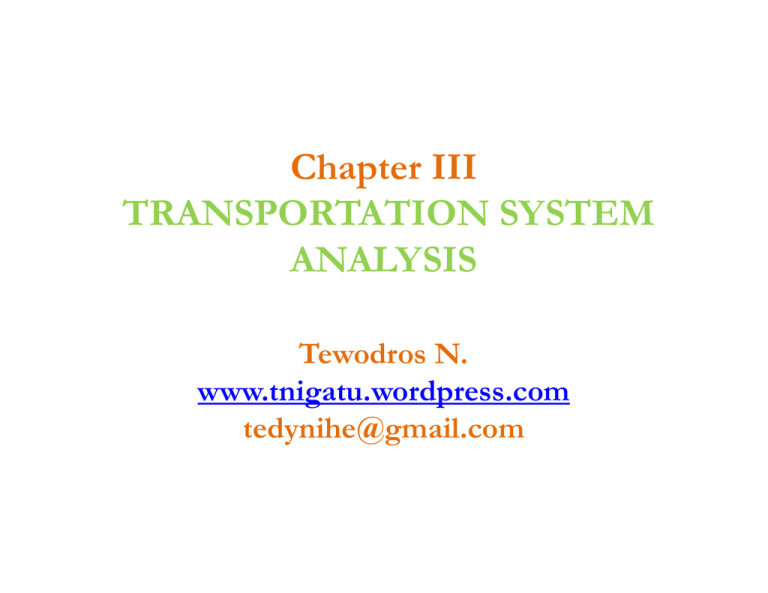
Chapter p III TRANSPORTATION SYSTEM ANALYSIS Tewodros N. www.tnigatu.wordpress.com tedynihe@gmail.com Lecture Overview Traffic engineering studies Spot speed studies Volume studies Travel time and delay studies Parking studies Fundamental F d l principles i i l off traffic ffi fl flow Traffic flow elements Flow-density relationships Fundamental diagram g of traffic flow Mathematical relationships describing traffic flow Shock waves in traffic streams Gap and gap acceptance Queuing Analysis Queuing Patterns Q Queuingg models Transport Engineering Tewodros N. School of Civil and Environmental Engineering Queuing Analysis Delay = actual travel - ideal travel time what is the ideal travel time? 1. Travel time under free flow conditions and 22. Travel T l time i at capacity. i Queuing delay:- delay that results when demand exceeds its capacity Queuing Q i Discipline Input Source (Customers) Queue Arrival Rate Served Customer Service Facility Queuing System Transport Engineering Tewodros N. Service Rate School of Civil and Environmental Engineering Input parameters Mean arrival rate (λ):- is rate at which customers arrive at a service facility. =3600/ Mean service rate (μ):(μ): is the rate at which customers (vehicles depart from a transportation facility. =3600// The number off servers (N) ( ) Queue discipline Transport Engineering Tewodros N. School of Civil and Environmental Engineering Queue Disciplines First in first out (FIFO):- first-come, first- served (FCFS) service discipline. Example:- Prepaid taxi queue at airports First Fi t in i last l t outt (FILO):(FILO) the h customers are serviced i d iin the h reverse order d of their entry. Example:- the people who join an elevator fi t are the first th last l t ones to t leave l it. it Served in random order (SIRO):- every customer in the queue is equally likely to be selected. Priority scheduling:- customers are grouped in priority classes on the basis of some attributes Example:- Treatment of VIPs in p preference to other p patients in a hospital Transport Engineering Tewodros N. School of Civil and Environmental Engineering Queuing Patterns Constant arrival and constant service rates Varying arrival rate and constant service rate Constant arrival rate and varying service rate Varying arrival and service rates Transport Engineering Tewodros N. School of Civil and Environmental Engineering Queuing models Notation for describing queue is given by X / Y/ N Where:- X the arrival distribution type should be used used, Y the service distribution type should be used, N represents the number of servers. M/M/1, M/M/N, Multiple single servers’ servers D/D/N Where:- D stands for deterministic:- the arrival and service times of each vehicle are known M stands Markovian:- exact arrival and/or service time of each vehicle is unknown Transport Engineering Tewodros N. School of Civil and Environmental Engineering M/M/1 model Arrival times and service rates follow markovian distribution or exponential distribution which are probabilistic b b ddistributions. b Only one server. Assumptions Customers are assumed to be patient. p System is assumed to have unlimited capacity. Users arrive from an unlimited source. The queue discipline is assumed to be first in first out. Transport Engineering Tewodros N. School of Civil and Environmental Engineering M/M/1 model Cont… Percentage of X number of customers are in the system. ݂((ݔݎ=)ݔ=ܺ(ܲ=)ݔ1−r) Where: ܷ = ݎݐ݂ܿܽ ݊݅ݐܽݖ݈݅݅ݐr = / Where: The average number of customers at any time in the system The average number of customers in the queue at any time is Expected time a customer spends in the system Expected time a customer spends in the queue Transport Engineering Tewodros N. School of Civil and Environmental Engineering Example 1 The Vehicles arrive at a toll booth at an average rate of 300 per hour. Average waiting time at the toll booth is 10s per vehicle. vehicle If both arrivals and departures are exponentially distributed, what is the average number of vehicles in the system, average queue length, the average delay d l per vehicle, hi l the h average time i a vehicle hi l iis in the system? Transport Engineering Tewodros N. School of Civil and Environmental Engineering M/M/N model Multi -server model with N number of servers Here H i the is h average service i rate ffor N identical id i l service i counters in parallel. For x=0 Transport Engineering Tewodros N. School of Civil and Environmental Engineering M/M/N model Cont… The average number of customers in the system is The average queue length The expected time in the system The expected p time in the qqueue Transport Engineering Tewodros N. School of Civil and Environmental Engineering Example 1 Consider the Example 1 as a multi-server problem with two servers in parallel. parallel Transport Engineering Tewodros N. School of Civil and Environmental Engineering Multiple single servers' model N numbers of identical independent parallel servers which receive customers from a same source but in different parallel queues each one receiving customers at a rate of / . Transport Engineering Tewodros N. School of Civil and Environmental Engineering Example 3 Consider the problem 1 as a multiple single server's model with two servers which work independently with each one receiving half the arrival rate that is 150 veh/hr. veh/hr Transport Engineering Tewodros N. School of Civil and Environmental Engineering D/D/N model The arrival and service rates are deterministic tthat at iss the t e arrival a va and a d service se v ce times t es of o each eac vehicle are known. A Assumptions i Customers are assumed to be patient. System is assumed to have unlimited capacity. Users arrive from an unlimited source. The queue discipline is assumed to be first in first out. Transport Engineering Tewodros N. School of Civil and Environmental Engineering Example 4 Morning peak traffic upstream of a toll booth is given in the table below. The toll plaza consists of three booths, each of which can handle an average g of one vehicle everyy 8 seconds. Determine the maximum queue, the longest delay to an individual vehicle. Transport Engineering Tewodros N. School of Civil and Environmental Engineering Solution Service rate is given as 8 seconds per vehicle. This implies for 10 min, 75 vehicles can be served by each server. Hence H 225 vehicles hi l can be b servedd by b 3 servers in i 10 min. i Transport Engineering Tewodros N. School of Civil and Environmental Engineering Tha k Y Thank You!!
